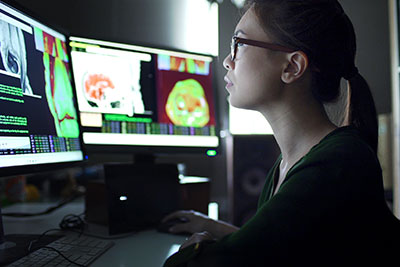The traditional clinical track is a four-year program consisting of a three-year core curriculum with a focused fourth year 10-month concentration offered in all subspecialty areas, followed by a traditional one-year fellowship. For super specialization, a trainee can start an individually designed two-year fellowship in their 4th year (see below).
 Core curriculum includes basic and advanced instruction in radiological procedures and image interpretation of all radiological subspecialties. Approximately one-third of rotations will be at Pennsylvania Hospital, less than two miles from the Hospital of the University of Pennsylvania (HUP). Residents also rotate at the Philadelphia Veterans Affairs Medical Center and Penn Presbyterian Medical Center, both of which are just a short walk from HUP. All sites of training are staffed by faculty, residents, and fellows from Penn Medicine. In addition, there is a three-month pediatric radiology rotation at the world-renowned Children's Hospital of Philadelphia (CHOP) and a four-week virtual rotation on radiological pathology at the American Institute for Radiologic Pathology (AIRP).
Core curriculum includes basic and advanced instruction in radiological procedures and image interpretation of all radiological subspecialties. Approximately one-third of rotations will be at Pennsylvania Hospital, less than two miles from the Hospital of the University of Pennsylvania (HUP). Residents also rotate at the Philadelphia Veterans Affairs Medical Center and Penn Presbyterian Medical Center, both of which are just a short walk from HUP. All sites of training are staffed by faculty, residents, and fellows from Penn Medicine. In addition, there is a three-month pediatric radiology rotation at the world-renowned Children's Hospital of Philadelphia (CHOP) and a four-week virtual rotation on radiological pathology at the American Institute for Radiologic Pathology (AIRP).
Divided into 39 four-week blocks, the first three years of residency include all required training to master general radiology and the Core Exam. This includes rotations in CT, US, Chest, Bone, GI, GU, MRI, Neuroradiology, Interventional Radiology, Pediatrics, Cardiovascular, Breast, Nuclear Medicine/PET, Nuclear Cardiology and Nuclear Medicine Physics. In addition, second year residents are assigned to Night Float and third year residents go to the AIRP. For each month of rotation, goals, objectives, and suggested readings with progressive responsibilities and expectations are distributed to the resident.
Meet our residents
Flexible Fourth Year Option
The program offers a flexible fourth year. For super specialization, a resident can begin a two-year fellowship in one of the following disciplines: Neuroradiology, Cardiothoracic Imaging, Oncologic Imaging, Women's Imaging, Musculoskeletal Imaging, Abdominal Imaging or Pediatrics.
The year is structured in ten four-week blocks and will allow residents to develop broad clinical, radiological, and basic scientific expertise as well as research competence in the chosen subspecialty. Relevant rotations outside radiology (in the clinic) are important components of these programs.
Residents may elect to pursue our ABR-approved 16-month pathway to certification in Nuclear Radiology. This is a very popular option. We have graduated the most double board-eligible residents in the country!
Residents also have the opportunity to elect our ACGME-approved ESIR program. We are the only program nationally that has been granted ABR approval to pilot combining the 16-month Nuclear Radiology fellowship with ESIR as well as incorporating the 16-month Nuclear Radiology fellowship into our IR residency. Three residents have graduated from these combined programs as of 2024.
Many residents elect to do one-year concentrations with a traditional fellowship to follow (essentially two fellowships!). Residents who do either one or two-year programs are given an official diploma for their concentration. An additional option is to do two five-month concentrations with a traditional fellowship to follow.
All programs can be individualized in conjunction with the program director.
Residents during their fourth year are required to attend at least five hours of fellow level lectures/interdisciplinary conferences. Two blocks of the fourth year will be spent operating in a more independent fashion doing a 4:30pm to 12:30am rotation at Penn Presbyterian Medical Center (our site for trauma), a 4pm-10pm “Private Practice” rotation, and Night Float at the Hospital of the University of Pennsylvania or Pennsylvania Hospital. We believe time spent in this fashion will reinforce the skill sets needed to successfully complete the Fundamentals of Diagnostic Radiology portion of the certifying exam.
Research
Radiology training at Penn Medicine fosters and facilitates original research by residents. Research spans the gamut, including basic science, translational, clinical, health policy, augmented reality, artificial intelligence, informatics, quality & safety, and medical education. The ACGME research requirement is strongly embraced by the department and is a pillar of our educational mission. In order to help residents fulfill this requirement, they are given one half day per week, or two days per four-week block, of dedicated research time during the first three years of residency.
Residents participate in a two-week rotation called How to be an Academic Radiologist (HTBAR) during the first year of residency. This provides an opportunity for residents to kickstart their research projects under the direction of faculty mentors.
Penn Radiology has a longstanding commitment to resident involvement in research: last year, 24 residents published 52 papers in peer-reviewed journals, and our graduating class of 2023 published 46 papers over their four years of residency.
Start Your Application